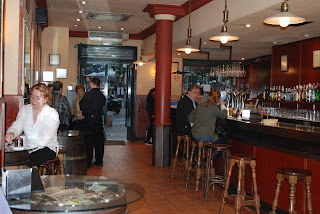
A walled city where none of the streets are level, they either go up or down, not too steep, but definitely make walking interesting, especially since they are also cobblestone and extremely narrow. God forbid you meet a car coming or going. I actually had the zipper on my jacket clipped by the passenger-side mirror of a fairly quickly moving vehicle as I tried to edge around a corner that interrupted what little sidewalk was present, thus forcing you into the street. Too close a call for me!
Welcome to Toledo! It is a city with 2,500 years of history and somewhat frozen in time about 700 years ago. In fact the city is so well preserved it has been declared a national monument. The ENTIRE CITY! And the Spanish government has forbidden any modern exteriors. (Of course like any government, I guess they are exempt for the new entry they added to the Alcazar when they renovated it into a national military museum is extremely modern. It totally clashes with the rest of the building and the entire city!)
We spent a marvelous day wandering the streets of Toledo (which is exactly what you do. Even with the Guide Maps it is nearly impossible NOT to get lost. At some point it seems every tourist does so, some multiple times, or they just give in and wander and take what the city provides, which is actually a treasure around every bend or corner in the maze of streets.) For a city whose life-blood is tourism, the signage to assist visitors in getting around is extremely poor. You will start down one direction because a sign designates that way to the Mezquita, for example, and then you never see another sign the rest of the walk. Yet along the way there are multiple forks in the road and you enter numerous small plazas with numerous entrances and exits. I have had a far easier time navigating the lakes and streams of the Boundary Waters Canoe Wilderness Area in northern Minnesota than I did navigating Toledo.
Perhaps it is actually designed as a tremendous spiritual exercise?! After all, it is a walled city. Three sides are bounded by the Tajo River. It is set on top of a hill. So you really cannot get "lost" but will always bump into an edge with an option to head back toward the center. It becomes a problem if you are a goal-oriented, accomplishment-driven American who feels you must see "all" of the sights, or at least a major portion of them. So this spiritual exercise of the streets of Toledo will either drive you mad, or it will begin to break through your "expectations" of what must be achieved and experienced and begin to lead you to slow down, grow patient, go with the flow and simply experience what the city, what life, has to open up before you and, if you slow down enough to look for it, surprise you with.
We did see some of the sights: the Cathedral (huge, immense, awe-inspiring, although after a little while inside, it actually began to feel "oppressive" for Dianne), the Synagogue which houses the National Jewish Museum, a second synagogue which was once a mosque, a Christian church, and for a while served as the stables for Napoleon's horses, and the Mezquita, a very ancient ruined mosque which also was once a Christian church and has some remaining Christian frescoes on the ceiling and the walls.
But we also enjoyed a delicious and slow-paced lunch at a little restaurant where the inside was packed with locals and the outside tables filled with tourists from Germany, Italy, USA, and several other places. We ordered the Menu de Dia (a three course meal). We each had the traditional Catalan Soup; Dianne had a veal steak that looked exactly like a Palomilla and I had venison stew (Toledo is known for its wild game options for dining). It was all washed down with a cheap bottle of Red Table Wine and topped off with flan. It was good and the afternoon sun warm and enjoyable and a nice respite in the middle of the day.
We also enjoyed a surprising invitation immediately after arriving and walking up the hill to the Cathedral, by a very friendly man who told us all about a little shop of artisans just 2 minutes away where we could watch them working, for free! We decided to accept his invitation, since it was only open until noon and it was already 10:30 a.m. He walked us down the hill about two blocks to a charming little shop in a back-alley where we were introduced to two gentlemen working on gold damascene jewelry. We then entered their shop and of course purchased some very nice quality craft work from craftsmen who have been plying their trade for 25, 30, and 48 years! It was a pleasant surprise!
Toledo was a good experience at just the right time. It invited us to slow down and soak in the location, rather than keep driving to achieve all the notches we could count on our traveler's staff. After today I feel we are beginning to find that balance we wanted to achieve between sight-seeing and simply living in and soaking up the surrounding culture and environment which is Spain.




















